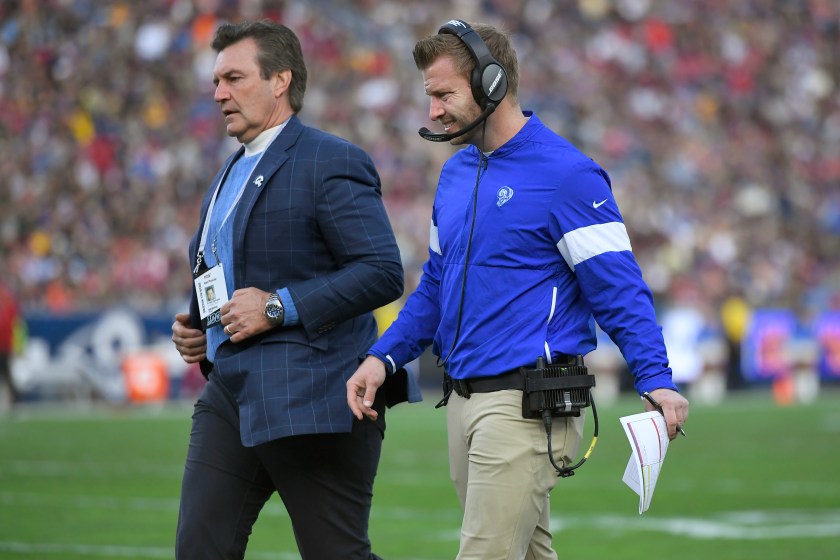When Aaron Rodgers went down, grabbing at his ankle just four plays into the 2023 season, you could hear Jets fans saying "not again."
The problematic franchise went big in bringing in the former MVP, but his Achilles rupture put the team back to Zach Wilson quickly. By the following Wednesday, Rodgers was on a table in Los Angeles, having his tendon repaired by Dr. Neal ElAttrache, team doctor for the Los Angeles Rams and one of the top orthopedists in the world.
Rodgers immediately put out a statement, and while most of it can be ignored like his latest wack-a-doo shenanigans, one part stands out. Rodgers believes he could return for the Jets' playoff run. While the implied confidence in Wilson and his teammates is nice, it's the idea that Rodgers could return in less than the normal 6-9 months that's truly notable.
But is it possible? The answer is maybe, but the mere possibility is stunning for what was a career-ending injury just a decade ago.
The Man Behind the Surgery: Dr. Neal ElAttrache
RELATED: Aaron Rodgers Replacement QB Options for New York Jets
ElAttrache has been at the forefront of Achilles repairs for better than a decade, though he's better known for his work on elbows and shoulders at the world-famous Kerlan-Jobe Clinic in Los Angeles, where Tommy John surgery and so many orthopedic advances were created. ElAttrache was part of this with his Achilles technique, first changing the way that the sutures were done, most notably with Kobe Bryant. While Bryant wasn't first, his dramatic injury and comeback get the notice, setting the milestone for the technique change.
An Achilles tendon rupture is one of the more dramatic injuries in sports. With Rodgers and Kevin Durant before him, the energy of the tendon retracting up to the calf can be seen, the waves pulsing through the muscle and visible even to medical novices.
A close up of the play on which Aaron Rodgers’ calf reverberates, and he winds up with what the Jets now believe is an Achilles injury, via @ACLrecoveryCLUB: pic.twitter.com/bcGeWGGiL0
— Adam Schefter (@AdamSchefter) September 12, 2023
While the injury is dramatic, the repair is mundane. Any tendon repair is done by stitching together the two ends of the damaged structure. If you've ever darned a sock, it wasn't dissimilar for years. Surgeons would try to get the length and tendon right, then lock it in place.
ElAttrache's initial change was in how he did the sutures. New materials and his steady hands allowed him to use smaller sutures and a way of knotting them off that caused less irritation and scarring. He was carrying research and technique from a shoulder labrum to the Achilles and it worked well, allowing players like Bryant to come back quicker and with a lower failure rate.
Like any good surgeon, ElAttrache didn't stand still. Instead, he has adopted a surgical technique that uses new devices that nearly eliminate the sutures themselves while also improving the way that the Achilles is tensioned, a key point to the surgery and performance after surgery. The technique and the devices used are both called "Speedbridge," or as Arthrex, the company that developed it, calls it, "the Achilles Midsubstance Speedbridge Repair."
The two key parts of the new technique augment the previous techniques, but take over the repair (sutures) and the tensioning with the titular Speedbrige. As shown in this Arthrex link, the Achilles is repaired by SutureTape, the substance also used in InternalBrace repairs, such as what got Brock Purdy back so well. Then, the tensioning is done with by looping a piece of material up and through the fibers of the tendon itself, allowing for two swiveling anchors to hold the tension, but allow for natural movement post-procedure.
Arthrex is proud to provide the latest advancements in Achilles repair with the minimally invasive Midsubstance SpeedBridge™ implant system. With this innovation, the repaired tendon is reinforced and protected by securing SutureTape with two SwiveLock® anchors in the heel bone. pic.twitter.com/ZGWv5Dnf5U
— Arthrex (@Arthrex) September 17, 2023
It's technical but for Rodgers, it means less holdups to getting back on his feet, literally. While previous Achilles repairs required months in a walking boot (and before that, in a cast or immobilizer), Rodgers can start doing more activities in weeks, once the anchors heal up. Drilling into bone creates a small, controlled fracture, so think of it like that.
While this technique is new and doesn't have long term studies to back it, similar techniques have been used in other procedures. SutureTape in ankles, knees and elbows has unprecedented success in a number of techniques, so this is hardly unproven, just new. By being willing to use something new and by trusting one of the top surgeons around, Rodgers does have a shot at being cleared and playing sooner than he could have with a standard Achilles repair. Whether that's quickly enough to be back in December or January remains to be seen, but the work has already started.

